

- 54. 10 Useful Pieces of Advice for Teaching with LEARNING WORLD #9 & 10
- 55. “Happy New Year!” “I don’t say that.”
- 53. Halloween 2019
- 52. READY Workbook Pg. 17
- 51. English-Uplift 1-Day Seminars
- 50. READY Workbook - vocabulary copying activity
- 49. 10 Useful Pieces of Advice for Teaching with LEARNING WORLD #8
- 48. 10 Useful Pieces of Advice for Teaching with LEARNING WORLD #7
- 47. 10 Useful Pieces of Advice for Teaching with LEARNING WORLD #6
- 46. 10 Useful Pieces of Advice for Teaching with LEARNING WORLD #5
- 45. 10 Useful Pieces of Advice for Teaching with LEARNING WORLD #4
- 44. 10 Useful Pieces of Advice for Teaching with LEARNING WORLD #3
- Kindergarten aged students
- Lower Elementary-school aged students
- Upper Elementary-school aged students
- Junior High and older students
- Others
11. "AJ Picture Dictionary: A little creative speaking and writing."
Did you have a relaxing New Year? I hope so!
With “How was your Winter Vacation?” lessons well and truly finished, our heads and our students’ heads are back into their textbooks…
As you know, I’m always keen to provide creative expression opportunities for students. AJ Picture Dictionary helps a lot with both creative speaking and creative writing.
Scene 18 “A School Play” is an interesting page, with musical instrument names and hairstyles commanding probably most of students’ focus.
In a class of middle to upper elementary school students….
1.Ss open their books to Scene 18.
After some general discussion on the contents of the page, I ask some specific questions (based on the grammar at the bottom of the page):
T: “Who’s that boy playing the tambourine?” Ss: “[That’s] AJ.”
T: “Who’s that girl playing ‘Tripitaka’?” Ss: “I don’t know…. Oh, that’s Cindy.”
T: “Who’s that woman holding the camera?” Ss: “That’s Bob’s mother.”
T: “Who’s that boy playing the Monkey?” Ss: “I don’t know…. Oh, that’s Jack.” (Bright Ss will find the answer at the bottom of the page!)
T: “What’s his name?” Ss: “I don’t know… Oh, that’s Jim.” (Again, bright Ss will find the answer at the bottom of the page!)
Then:
T: “Who’s the boy playing the guitar?” Ss: “I don’t know…”
T: “That’s Masato!”
Using students’ names in the same context will generate the English “I can’t play [the guitar]” etc.
2. Using cut-up photocopied pictures of each orchestra player, Ss create “four groups” of pictures.
Students’ groupings are interesting: [very big/big/small/very small], [black/brown/gold/others] etc. Musically experienced students may group the instruments according to their classification: [brass/woodwind/percussion/string], though they very rarely know this English specifically. (Incidentally, the piano is outside classification as it’s neither a string instrument nor a percussion instrument. The synthesizer is classed as an Electronic instrument).
3. Ss are given a white B4 sheet of paper and are instructed to fold it into eight boxes.
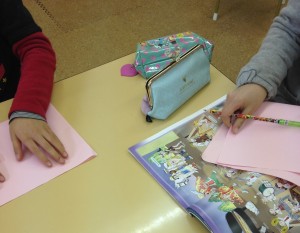
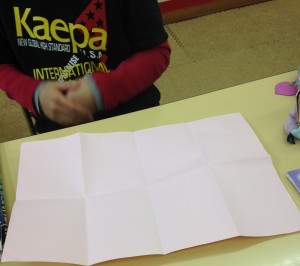
4. Ss are given strips of paper with English.
Each strip is given one at a time!
Each strip is glued into a box on the B4 paper, and Ss draw its picture.
Strip #1: “a girl playing a trumpet”
Strip #2: “a boy playing __ ___________” (Ss write an instrument of their choice).
Strip #3. “a ______ playing ___ ________”
Strip #4: “a ______ _____ ___ _________”
Students are allowed more creative freedom with each strip of paper. The drawing of each picture takes time. The very first picture “a girl playing a trumpet” is completed in class. Depending on time, other pictures can be done for homework.
Next, Strip #5: “a girl with a braid”
Students initially look for an instrument called “a braid”(!) Eventually this English is noticed amongst the hairstyles of the audience.
Strip #6: “a man with a _________”
Strip #7: “a woman with ________________”
Strip #8: “a _____ with _________________”
Once completed, the B4 paper looks like this:
I love AJ Picture Dictionary. Again and again, it offers students important creative writing experiences. Hopefully you can bring these experiences to your classroom too!












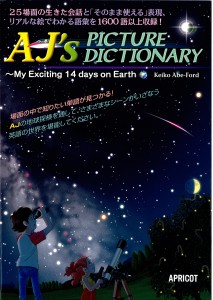
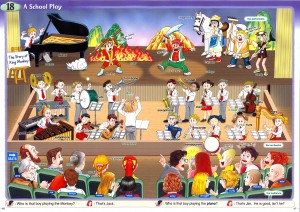
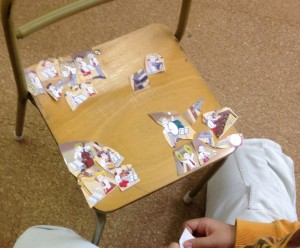 ←Click to enlarge
←Click to enlarge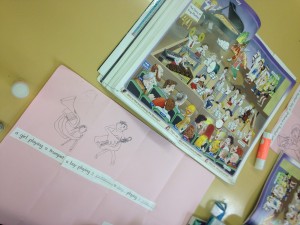 ←Click to enlarge
←Click to enlarge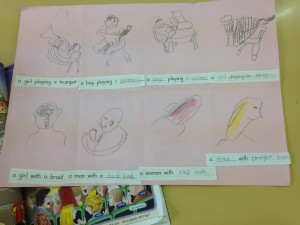 ←Click to enlarge
←Click to enlarge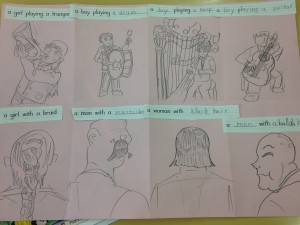 ←Click to enlarge
←Click to enlarge







